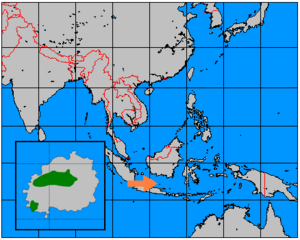Bawean deer facts for kids
Quick facts for kids Bawean deer |
|
|---|---|
 |
|
| Adult male at the Ragunan Zoo, Jakarta | |
| Conservation status | |
| Scientific classification | |
| Genus: |
Axis
|
| Species: |
kuhlii
|
 |
|
| Orange arrow points to Bawean Island. Green on inserted map highlights approximate range of Bawean deer on the island. |
|
| Synonyms | |
|
|
The Bawean deer (Axis kuhlii) is a special type of deer. It is also called Kuhl's hog deer. This deer lives only on Bawean Island in Indonesia. It is a threatened animal.
The Bawean deer is in great danger. Its home is being destroyed. Also, there are not many of them left. Because of this, experts say it is critically endangered. This means it faces a very high risk of disappearing forever.
About the Bawean Deer
Bawean deer are not very tall. Male deer are usually about 60 to 70 centimeters (about 2 feet) tall. They have antlers with three points.
Their fur is short and soft. It is usually light brown. They have a few yellow marks on their head and neck. They also have a light patch under their throat. A white ring goes around their eyes. Baby deer, called fawns, have white spots on their backs. This helps tell them apart from other deer.
Deer Families and Habits
Bawean deer like to live in forests. They prefer areas with thick plants. This dense growth gives them shelter. They rest and sleep there during the day.
These deer live in small groups. A group usually has four or five deer. This often includes one female, her baby, and two males. They are herbivores, meaning they eat plants. They munch on grasses, herbs, leaves, and twigs. They also eat corn and cassava plants.
Female deer usually have one baby each year. The baby grows inside the mother for about 225 to 230 days. Most babies are born between February and June.
Male deer can be quite protective. They might act aggressive towards other males. They use special smells to mark their territory. When they run from danger, they keep their heads low. They trot quickly. Their back also curves high up. If a baby is with them, the males run in front. The female runs behind. This helps keep the baby safe from predators.
Protecting the Bawean Deer
The Bawean deer faces many challenges. Their homes are shrinking. Climate change also affects them. This includes warmer oceans and more floods.
The government of Indonesia passed a law in 1977. This law helps protect the Bawean deer. Thanks to this law, their numbers have slowly grown. Still, the Bawean deer is considered critically endangered. This means it needs a lot of help to survive in the wild.


